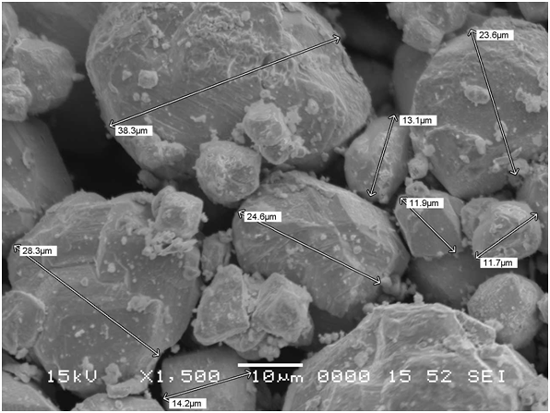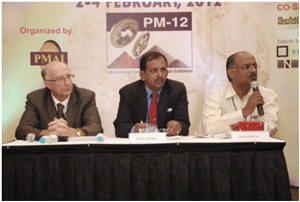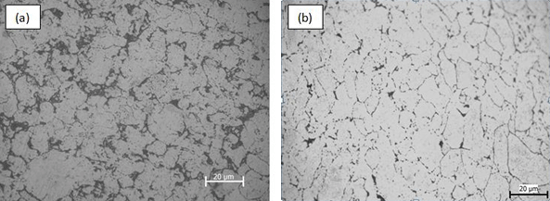PM-12 India: Developments in Particulate Materials Research
Coarse tungsten manufacturing
Tungsten carbide grades used for interrupted cutting and heavy duty applications require coarse WC and hence coarse tungsten particles above 10 micrometers. Guruprasath J, Shivaram G, Sudarshana Shetty, ThillaiRajan A, and K Chandrashekar Shenoy of Kennametal India Limited, Bangalore, presented their research work carried out in an industrial scale on the factors controlling tungsten particle size during reduction from its oxide. Addition of dopant (alkali metal tungstate) caused a reaction with hydrogen forming WO2 and water molecule and thus increased the pH2O/pH2 ratio. This resulted in grain growth by Chemical Vapour transport. Tungsten particles of size of 10 to 15 µm were manufactured using 50ppm dopant at a feed rate of 2.5 cm/min.

Fig. 1 SEM Morphologies of Tungsten Powder made using 70 ppm dopant with a feed rate 5Cm per 2.5 minutes and H2 gas flow rate 25 m3 per hour at 950°C. The average particle size of the powder by Fisher sub sieve sizer is found to be 19 micrometers.
Depending on the functional requirement of the tungsten carbide tools, the binder content varies from 3 to 30wt%. Typically forging dies require very high toughness to withstand the impact load and hence uses carbide with 22 to 28wt% cobalt as binder. However, sintering with accurate dimensional control of carbides with such a high fraction of binder is a challenge. Subsequent grinding requirements had to be increased resulting in higher cost of grinding and loss of expensive carbide material.
Dimension control of sintered WC-Co compacts containing high cobalt
In a separate research paper, Khilendra Kumar, Vaishali Jagannath, Sudharshan Shetty and Alok Bhaskar of Kennametal India Limited, Bangalore, presented a correlation between the sintered and green dimensions of high cobalt containing compositions using a regression analysis. This helped in fairly accurate prediction of the sintered dimensions by controlling the dimension after compaction, and helped in a reduction of grinding requirements after sintering.
A topic of immense importance to the nuclear industry is the successful development of core materials for fast breeder reactors. These are subjected to a demanding environment of high fast neutron flux coupled with high temperatures and high thermal gradients. In the long term, F/M steels (9-12% Cr) have been identified as the core component structural materials, due to the inherent low swelling behaviour of bcc ferrite. However, increase in the Ductile to Brittle Transition Temperature (DBTT) due to irradiation, low high temperature creep resistance are causes of serious concern for use of ferritic steels.
Presently, reduced-activation ferritic/martensitic (RAFM) steels are used as main candidates for fast breeder reactors. Molybdenum was replaced by tungsten to produce Cr-W steels as an alternative to Cr-Mo steels and niobium was replaced by tantalum. The creep properties of ferritic/martensitic steels can be improved by introducing thermally stable oxide dispersions in the ferrite or ferrite/martensite matrix.
Comparative study of microstructural development during sintering and powder forging of ODS steels
R. Sunil Kumar, M. Zinzuwadia, V.V. Dabhade and U. Prakash of the Department of Metallurgical and Materials Engineering, Indian Institute of Technology, Roorkee, India have discussed their work on the comparative study of micro structural development during sintering and powder forging of ODS steels.
The work was conducted using pre-alloyed ferritic stainless steel powders of 409L (Hoganas, Pune) and. micron (4 μm) and nano (10 nm) sized yttria powders from Alfa-Aesar (Hyderabad). Six alloys with varying yttria of both sizes and composition (0.1%, 0.3% & 0.5%) were prepared by high energy milling in a planetary mill. In the sintering route these were compacted at 650 MPa, coated with glass and sintered in air at 1100°C for 1 hr. In the cold forging route, the powders were cold forged at 1000 MPa, glass coated, heated at 1000°C in air for 1 hr and were hot forged at 1000MPa
A finer microstructure was observed both in sintered as well as forged samples, with a decrease in yttria particle size and an increase in amount of yttria particles. The forged samples showed well defined grains with finer pores and lesser porosity as compared to sintered samples. Clear grains were observed in forging, whereas particle boundaries and neck formation was observed during sintering. Forged samples showed densities of 96-97% as compared to sintered samples which exhibited 82-86%.
Powder Metallurgy processing of aluminium-short steel fibre composites
Aluminium powder metallurgy is rapidly becoming popular and is likely to play major role in the future, judging by the number of research papers presented in this conference. Also, IIT Roorkee seems to be doing very good research in the field of particulate materials. S. Jain, D. Fabijanic, K. Chandra and V. Agarwala have presented their work on the powder metallurgy processing of aluminium- short steel fibre composites. Composites of Al-0.5 wt. % Mg metal matrix reinforced with 10-30 wt. % short steel fibres are made by sintering and subsequent consolidation techniques of forging and rolling.

The concluding session was chaired by Greg Lavalle,
Executive Director QMP Powders Rio Tinto, Canada.
Left to right: G Lavalle, P N S Sivan and
Dr. Murligopalakrishnamurthy
Steel fibres are relatively inexpensive reinforcement as compared to the dominant ceramic additions in vogue. Also, the 0.38 wt. % C plain carbon steel fibres of average diameter 50µm and length 1000-1500 µm are commercially used as reinforcement in phenolic resin based brake pads. The matrix powders and reinforcing fibres were blended for uniaxial cold compaction and sintered under pure nitrogen atmosphere at 620°C for 1h.
It was observed that density, hardness and porosity increased with increasing content of short steel fibres. The sintered compacts were forged in a closed die to attain complete density. Mechanical properties were determined for as-forged and subsequently rolled specimens. Significant improvements in ductility were observed vis-à-vis reported work for cast counterparts and appreciable increase in high temperature strength was obtained. Wear studies on the sintered composites using ball-on-disc tests revealed a substantial increase in room and elevated temperature (250°C) wear resistance with increasing reinforcement content.
News | Articles | Market reviews | Search directory | Subscribe to e-newsletter






